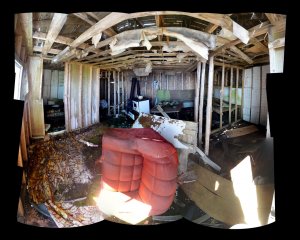
Michael Flaherty: the Grey Islands

In the summer of 2009, artist Michael Flaherty travelled to the uninhabited Grey Islands, just off the tip of the Northern Peninsula of Newfoundland. A trained ceramicist, his three-month stay in this remote location was both a conceptual and craft-based project, engaged with what he called the “hierarchy of material and concept in ceramics.” The plan was to build an outdoor kiln on one of the islands, but inside out. Flaherty inverted the kiln’s design so as to place the entire island conceptually inside it. Firing the kiln would, at least symbolically, fire the island. The project could be understood in a number of ways: as a sort of wilderness adventure, part of a grand Canadian tradition (not least for artists); as an artistic intervention in a real landscape; as a ritual act that resonated with the island’s history as a site of “resettlement” now returned to nature; and as a restatement of art’s debt to, and need to distance itself conceptually from, the hand-based labour of craft.
Flaherty’s solitary “artist residency,” perhaps inevitably, became something more in the end, and developed into a need to respond to the islands, a springboard for several years of artistic production. The entire journey, and the action of firing the island, could be read as a spatial and temporal engagement with loss—lost time, as Flaherty visited the remnants of the fishing village of French Cove and engaged in an archaeological project, and lost space, as the artist explored the island wilderness now reclaimed by caribou and other wildlife. While making the outdoor kiln, he carefully documented both his own activities (the record of a personal experience and an artistic act), and what he found there, the residue of both a history and living situation rich enough that a symbolic firing could only be read as a self-conscious gesture of representational failure, pointing to the vanity of any individual attempt at closure. The result is a complex body of work that both opens up a historical narrative, and contends with the strengths and limitations of every possible way of transmitting it, whether subjective and active, or objective and ostensibly passive.
The Grey Islands, like so many outports in Newfoundland, were abandoned during the period of the 1960s and 1970s, during a time of government-driven resettlement. Flaherty documented the remnants of the fishing village of French Cove, and also uncovered pottery shards and other artifacts from this time. At the same time, he encountered caribou herds (it is notable that these were originally introduced by humans), and their own remnants in the form of antlers scattered across the island’s barren fields. The history of resettlement thus includes more than just human habitation. Ultimately the story speaks more of a shift in ownership than it does of abandonment.
Flaherty pays tribute to the past and present of the Grey Islands with his series Rangifer Sapiens, the centrepiece of this exhibition. This group of 21 ceramic works is akin to a treasure found among ruins. It physically joins recreations of both antlers and pottery shards, painted in a decorative style based on Victorian porcelain. The Grey Islands, then, is more than archaeological documentation. Combining the forms of natural and human artifacts, the artist brings together the past and present, and explores the borders of nature and culture in a body of work that ranges from the romantic enaction of an imagined fusion with the wilderness, to the melancholy recognition of its end.
-Pan Wendt, Curator

